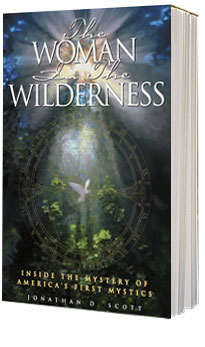The Lamenting Voice
A collection of hymns by Johannes Kelpius

One of the few artifacts of Johannes Kelpius that has survived is a hymn book about 5 x 7 inches, likely bound by Kelpius' close friend, J.G. Seelig in 1705. About this unusual piece, Julius Sachse the historian wrote:
"This unique volume of seventy pages contains twelve hymns and melodies. It is evidently a duplicate of a similar manuscript collection, or else it is a compilation from loose sheets upon which were originally written such hymns as were in common use in the services at the Tabernacle. The hymns are written in German on the left hand pages, while on the opposite pages is an attempt at a metrical translation in English. The musical score as well as the hymns are all in the peculiar handwriting of Kelpius, and, like his diary, the book affords us an insight into his religious fervor.
Most of the hymns are written somewhat after the style of the celebrated Christian Knorr, Baron von Rosenroth, whose name is quoted in connection with the melody of several of the compositions. The English translations are mere paraphases, and fail to convey the full fervor and meaning of the German original."
The translator of the hymns was most likely Christopher Witt.
The German name of this hymnbook is:
Die Kl'aglige Stimme
der
Verborgenen Liebe
zur zeit da Sie
Elendund Verlassen
darnieder lag
und von
Der Menge ihrer Feindegedranget undgeanchstiget
Wurde von einemn in Kummer
The Lamenting Voice
of the Hidden Love,
at the time when she lay in Misery and forsaken
and oppressed by the multitude of her enemies.
Composed by one in Kumber
One of the hymns found in this collection is entiled "The Best Choice." It is also known by its first line as "Ich liebe Jesus noch allein," translated as "I Love My Jesus Quite Alone."
Click to hear the music of The Best Choice, a hymn to which Kelpius wrote the words, translated (as shown below) by his friend, Dr. Christopher Witt.Ich liebe Jesus noch allein
I love my Jesus quite alone.
The Bride, the Bridegroom of my spirit;
No others shall my heart, no, none,
Through love, through loving more inherit.
No man can do at once for two.
For one’s, for one’s will and for t’others:
Therefore I’ll leave all others.
The magnet needle erring goes,
When from, when from the pole distracted.
And take before quite no repose,
Till he, till he has her attracted.
And since my heart with Thy love dart
Is touched, is touched by its flaming ether,
Therefore, they haste together.
And though Thou art like the north star
In Heav…in Heaven altified
And I on earth so distant far
I’ll fol…I’ll follow undenied.
Still Thee my Light, and my eyesight.
Shall still, shall still be turned to Thee,
From every place, and woo Thee.
Ich liebe Jesum mir allein
Den Brautgam meiner Seelen;
Kein andrer soll mein Herzelein
Durch Liebe mir abstehlen.
Niemand kan Zwei
Mit gleicher Treu
Zu einer Zeit unfassen,
Drum will ich Andrer lassen.
Mein Ohr allein nur deine Stim
Mit Andacht soll anhören.
Wann einer Fremden ich vernim
Lass ich mich drum nicht stören.
Mann kann ja nicht
Mit treuer Pflicht
Swei widrigen anhören;
Meiner Jesus soll mich lehren.
Die Magnet Nadel irrn geht
Wann sie vom Pol verrücket ist;
Auch gar nicht ehe stille steht
Bis ihr sie zu süss zücket.
Und weil mein Herz
Dein liebes Herz
Berufet mit ihren Flammen.
Drum eilen sie zusammen.
Gehörsam hör ich deine Stim
Wann mein Herz zu dir fahret.
Und ich hin wiederum vernim
Was mich dein Mund da lehret;
Drum ob du schon
Ins Himmel’s Thron
So weit bist abgelegen,
Bist mir doch zugegen.
Follow the links on this page for more hymns and related information.
Christian Knorr, Baron v. Rosenroth, was born at Altrauden, in Silesia, July 15, 1636. After studying at the universities of Leipzig and Wittenberg, he made an extended tour through France, England and Holland. At Amsterdam he became acquainted with an Armenian prince ; with the chief Rabbi, Meir Stern, from Frankfort; a M. Dr. John Lightfoot, Dr. Henry More, and others, and as a result devoted himself to the study of Oriental languages, of chemistry and of occult and Cabbalistic philosophy. He edited various Rabbinical writings, published several Cabbalistical works, notably his Kabbala Denudata (2 vols. Sulzbach, 1677). He, however, is chiefly known by his hymns, published in Nuremberg, 1684, under the title Never Helicon Mil Seiner Neun Musen ; das iis, Geistliche Sitten Lieder A number of these hymns were incorporated in the Halle Hymnal, 1704 Geistreicher Lieder),since when they have been translated into different languages, and are now used by nearly all Protestant denominations throughout the world.

